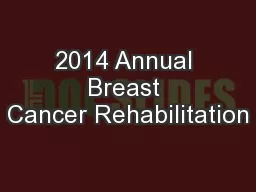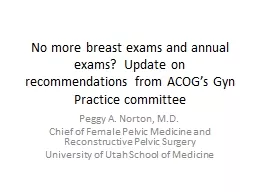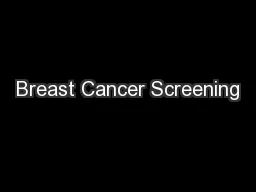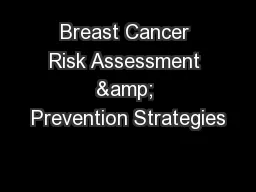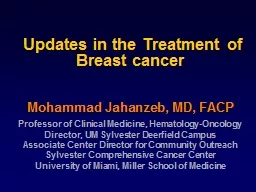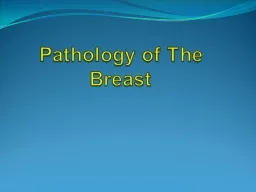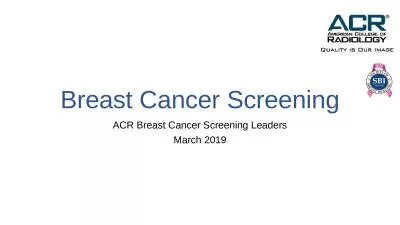PPT-2014 Annual Breast Cancer Rehabilitation
Author : jane-oiler | Published Date : 2018-11-05
Healthcare Provider Event A Manual Therapy and Exercise Approach to Breast Cancer Rehabilitation Course November 7 th and 8 th 2014 Mercer University Atlanta GA
Presentation Embed Code
Download Presentation
Download Presentation The PPT/PDF document "2014 Annual Breast Cancer Rehabilitation" is the property of its rightful owner. Permission is granted to download and print the materials on this website for personal, non-commercial use only, and to display it on your personal computer provided you do not modify the materials and that you retain all copyright notices contained in the materials. By downloading content from our website, you accept the terms of this agreement.
2014 Annual Breast Cancer Rehabilitation: Transcript
Healthcare Provider Event A Manual Therapy and Exercise Approach to Breast Cancer Rehabilitation Course November 7 th and 8 th 2014 Mercer University Atlanta GA Sponsored By TurningPoints Edith Van RiperHaaseBreast Cancer Rehabiltation Advocacy Fund. nbcamorg reast cancer is the second most common kind of cancer in women About 1 in 8 women born today in the United States will get breast cancer at some point The good news is that many women can survive breast cancer if its found and treated earl G. yn. . P. ractice . committee. Peggy A. Norton, M.D.. Chief of Female Pelvic Medicine and Reconstructive Pelvic Surgery. University of Utah School of Medicine. Learning Objectives. Describe the source of committee opinions and practice bulletins in ACOG. What’s New to Know?. The Issue of Breast Density. Catherine Babcook MD. Partner, Mountain Medical Physician Specialists. Medical Director of Breast Imaging McKay Dee Hospital Center. Disclosure. This presentation has no commercial content, promotes no commercial vendor and is not supported financially by any commercial vendor. I receive no financial remuneration from any commercial vendor related to this presentation.. Changing Philosophies in Educating Women and Teens . Courtney Benedict CNM MSN. Disclosures. Merck Nexplanon trainer . Session Objectives. Explain the rationale for initiation and frequency of clinical breast exams to clients. Generosa. . Grana. , MD. Professor, Cooper Medical School of Rowan University. Director, MD Anderson Cancer Center at Cooper. Overview. Factors that affect breast cancer risk. Tools to assess risk. Role of genetics in this process. Inspection. Size. S. ymmetry (some variation is normal) . Shape. Contour (flattening, masses, and dimpling). S. kin (color, edema, rashes, thickening, and venous pattern). S. cars (previous surgery, injuries). Mohammad . Jahanzeb. , MD, FACP. Professor of Clinical Medicine, Hematology-Oncology. Director, UM Sylvester Deerfield Campus. Associate Center Director for Community Outreach. Sylvester Comprehensive Cancer Center. Rajiv Doddamani. . PGY – 3, Internal Medicine . . St. Joseph Mercy Ann Arbor . Learning objectives . Explain the principles of breast cancer screenings . group. of diseases. . All forms of cancer cause cells in the body to change and grow out of control. . Most types of cancer cells form a lump or mass called a . tumor. . . The tumor can invade and destroy healthy tissue. Cells from the tumor can break away and travel to other parts of the body. There they can continue to grow. . Most of these lesions are benign. Breast cancer is 2. nd. most common cause of cancer deaths in women, following. carcinoma of the lung. . The clinical significance of the . benign. conditions:. 1- possible clinical confusion with malignancy. L. MEYSKENS, D. (32, 33), and hormonal (42, 46, (60, 78). 57, 66, cancer in is less Klinefelter'n syndrome with male authors measured et al. the formation ofestrone results rerrmin in males been repo March 2019. Preview/Introduction. The Risk of Breast Cancer to Women. Does Mammography Save Lives?. When to Start and How Often Should Women Screen?. Risks Versus Benefits of Mammography. Breast Cancer: The Impact on Women. Presenter: Carolyn . Taylor. . Paul . McGale. , Jake Probert, John . Broggio, . Jackie . Charman. , . Sarah Darby. , Amanda Kerr, Tim Whelan, . David Cutter, . Gurdeep. . Mannu. , David . Dodwell. 1. Module 4. Introduction. Training content for managing cancer as a long term condition. Purpose. The content within these slides can be used and adapted for local use in Protected Learning Time and other training sessions on cancer as a long term condition..
Download Rules Of Document
"2014 Annual Breast Cancer Rehabilitation"The content belongs to its owner. You may download and print it for personal use, without modification, and keep all copyright notices. By downloading, you agree to these terms.
Related Documents

